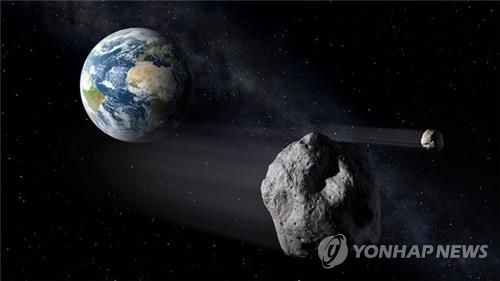This year, the largest celestial body close to the earth passed through “Musa” at about 2 million km on the 21st.
At 124,000 km/h, it passes 5.25 times the distance from the Earth to the Moon… Opportunities for close observation of asteroids

(Seoul = Yonhap News) Reporter Eom Nam-seok = ‘2001 FO32’, the largest of the asteroids passing by the Earth this year, passes through the Earth at a distance of about 2 million km on the 21st.
This is 5.25 times the distance between the Earth and the Moon. Although it is quite close in astronomical units, it is predicted that there is no possibility of collision, and it is expected to be a good opportunity to observe relatively large asteroids up close.
The asteroid’Apophis’, which is expected to approach the Earth by about 37,000 km in April 2029, passed by about 16.8 million km from Earth on the 6th.
Classified as a “potentially dangerous asteroid” according to the National Aeronautical and Space Administration (NASA) Jet Propulsion Research Institute (JPL), the 2001 FO32 has an elliptical inclined orbit at an angle of 39 degrees from the Earth’s solar orbit (ecliptic plane), which is faster than other near-earth asteroids It passes through the Earth at 124,000 km.
The 2001 FO32 has an orbital period of 810 days, and after this passage, it will not approach Earth until it passes 2.8 million km, which is about 7 times the Earth-Moon in 2052.

The 2001 FO32 was measured to be about 1 km wide in the first optical observation, but it was found to be about 440 to 680 m in infrared observation by’NEOWISE’, which monitors NEO near the Earth.
Even though it is only 440m, which is the lower limit, it is the largest among asteroids close to Earth this year. Recently, as a large asteroid close to Earth, ‘1998 OR2’, which passed on April 29 last year, is counted, and its width is about 2 km. However, the distance from Earth is 6.3 million km, which is more than three times farther than the 2001 FO32.
JPL predicts that through the close pass of the 2001 FO32, it is possible to determine the size and reflectivity of the asteroid, its composition, and the presence of a satellite (moon).
Infrared spectroscopy of NASA’s Infrared Telescope (IRTF) on Mauna Kea, Hawaii, equipped with a 3.2m main diameter telescope, and radar observation of the Deep Space Network (DSN) will be utilized.
First, through infrared spectroscopy, the wavelength of sunlight reflected from the surface of the asteroid is analyzed and compared with meteorites that have fallen to the earth to determine the mineral components that make up the 2001 FO32.
In addition, DSN’s dish antenna facilities installed in Goldstone, Spain, Madrid, and Canberra, Australia, are used as radars to more accurately measure the surface characteristics of asteroids, such as rocks and impact balls, and the rotational rate.
About 15% of the 2001 FO32-sized asteroids carry small satellites, and this close pass is expected to be able to confirm that they have satellites.

Of the NEOs, more than 95% of asteroids similar to or larger than the 2001 FO32 have been identified and tracked in orbit. None of the large asteroids on the NEO list have the potential to collide with Earth in the next 100 years, and it is known that the possibility of collision of other large asteroids with unknown orbits is extremely slim. However, research is ongoing on all celestial bodies that could pose a risk of collision, in that the more we learn about NEO, the more reliable Earth defenses can be.
The 2001 FO32 is only visible in the southern hemisphere sky and can be viewed with a telescope of 8 inches or more.
[email protected]
(End)
<저작권자(c) 연합뉴스, 무단 전재-재배포 금지>
